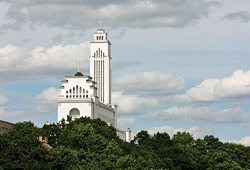History
At the start of the 20th century, when Lithuania had only recently regained independence, the idea arose of building a church in the Žaliakalnis neighbourhood of Kaunas as a monument to independence. That initiative in 1922 was backed by many distinguished people. But a financial crisis made it impossible to build a large memorial right away. So, to start, a small provisional church was set up. The monumental shrine idea revived in 1926 as Lithuania prepared to celebrate 10 years of freedom. Representatives from all sectors of society, at a meeting initiated by Archbishop Juozapas Skvireckas (1873–1959), took the decision to build a “national shrine” that would perpetually recall the recovery of independence. The undertaking was based on a conviction that a nation that believes in the Resurrection of Christ is invincible.
Karolis Reisonas (1894–1981), whose design for the sanctuary was approved in 1933, sought to harmonize the notions of church, monument and modernity in what was expected to become a paradigm of 20th century architecture. The project demanded a modern style, an innovative structure, the best construction materials and excellent workmanship. Among other functions, the building was also intended to serve as Lithuania’s ‘Pantheon’, with a crypt to bury people who had distinguished themselves in service to the nation. The remains of some already deceased important national figures would also be transferred there.
The foundation of the church was blessed in 1934 during Lithuania’s first Eucharistic Congress. A rather large cube-shaped rock brought from the Mount of Olives in the Holy Land was cemented into the foundation as the cornerstone. After that event, however, work on the building was often slowed or disrupted by to a continual lack of funding. The walls of the church finally went up in the summer of 1938, and the entire structure was in place by the spring of 1940. Then in June of 1940, with the plaster work on the internal walls half complete, the Soviet Union occupied Lithuania.
The Soviet authorities confiscated the nearly finished church building. Then, during the German occupation, the church was turned into a storehouse for paper. Finally, the Soviets returned. In 1952, Stalin signed an order to set up a radio receiver factory in the not yet furnished church. The building was reconstructed for its new purpose. Reinforced concrete slabs were used to divide the central nave into five floors and the lateral naves into three floors each. And in 1956 the Banga Radio Factory began to operate here. Parishioners, for their part, had to make do throughout the years of Soviet occupation with the small temporary wooden church that had been built before the war.
In 1988, with the process of national rebirth well underway, the Lithuanian people began to demand that the church be returned to the faithful. That finally occurred in 1990. The Banga factory agreed to gradually transfer operations to other premises by 1993, and to renovate the building at its own cost in order to return it in the same condition as when the factory first obtained it. Unfortunately, the radio factory went bankrupt before it could fulfil its promise to repair the church.
Reconstruction of the church was overseen by Fr Gintautas Kabašinskas in 1991, Fr Eugenijus Bartulis from 1992 to 1995, Fr Viktoras Brusokas from 1995 to 2002, and thereafter by Monsignor Vytautas Grigaravičius. Since money was always lacking, the restoration effort at first progressed very slowly. In 1996, all the remaining equipment from the radio factory was removed from the edifice. On November 9, 1997, Archbishop Sigitas Tamkevičius, accompanied by several other bishops and a group of priests, celebrated the first Holy Mass in the church, which was covered in scaffolding. Before the Mass, the archbishop blessed the church and the main altar. During Lithuania’s second Eucharistic Congress in Kaunas the days of June 1–4, 2000, among the scaffolding in the church Holy Mass was celebrated and other events for young people were held. Holy Mass began to be celebrated here every Sunday beginning July 1, 2002, in a setting marked by ongoing construction work.
Significant support from the Kaunas municipality in 2004, and from the national government in 2005, helped to accelerate the work and advance towards completion. The rooftop chapel dedicated to Our Lady of Šiluva was blessed in July 2004. Then on December 26, 2004, Christ’s Resurrection Church was solemnly consecrated to God. A large number of people took part in the ceremony. Dignitaries included Cardinal Audrys Juozas Bačkis, Kaunas Archbishop Sigitas Tamkevičius, Lithuanian President Valdas Adamkus and representatives of the Kaunas city government.
On February 16, 2006, Archbishop Tamkevičius blessed the columbarium, which was installed beneath the church as a burial place for people distinguished in service to the Church and to Lithuania. On November 4 of that same year, the first urn was placed here with the remains of Fr. Feliksas Kapočius (1895–1971), who helped to build Christ’s Resurrection Church. His remains were transferred from the United States. On May 23, 2008, Fr. Antanas Paškus (1924–2008) was buried in the columbarium. Fr. Paškus was a professor of psychology and philoosophy and the other of numerous books.
A tomb beside the church contains the remains of the well known Lithuanian ecclesiastic and politician Prelate M. Krupavičius (1885–1970), brought in 2006 from the U.S.A. In 2008, Monsignor Vytautas Kazlauskas – a professor, doctor of theology and long-time Lithuanian editor of Vatican Radio who founded and developed the catholic charity for the care of orphans “Vaiko Tėviškės Namai” – was also buried here.








